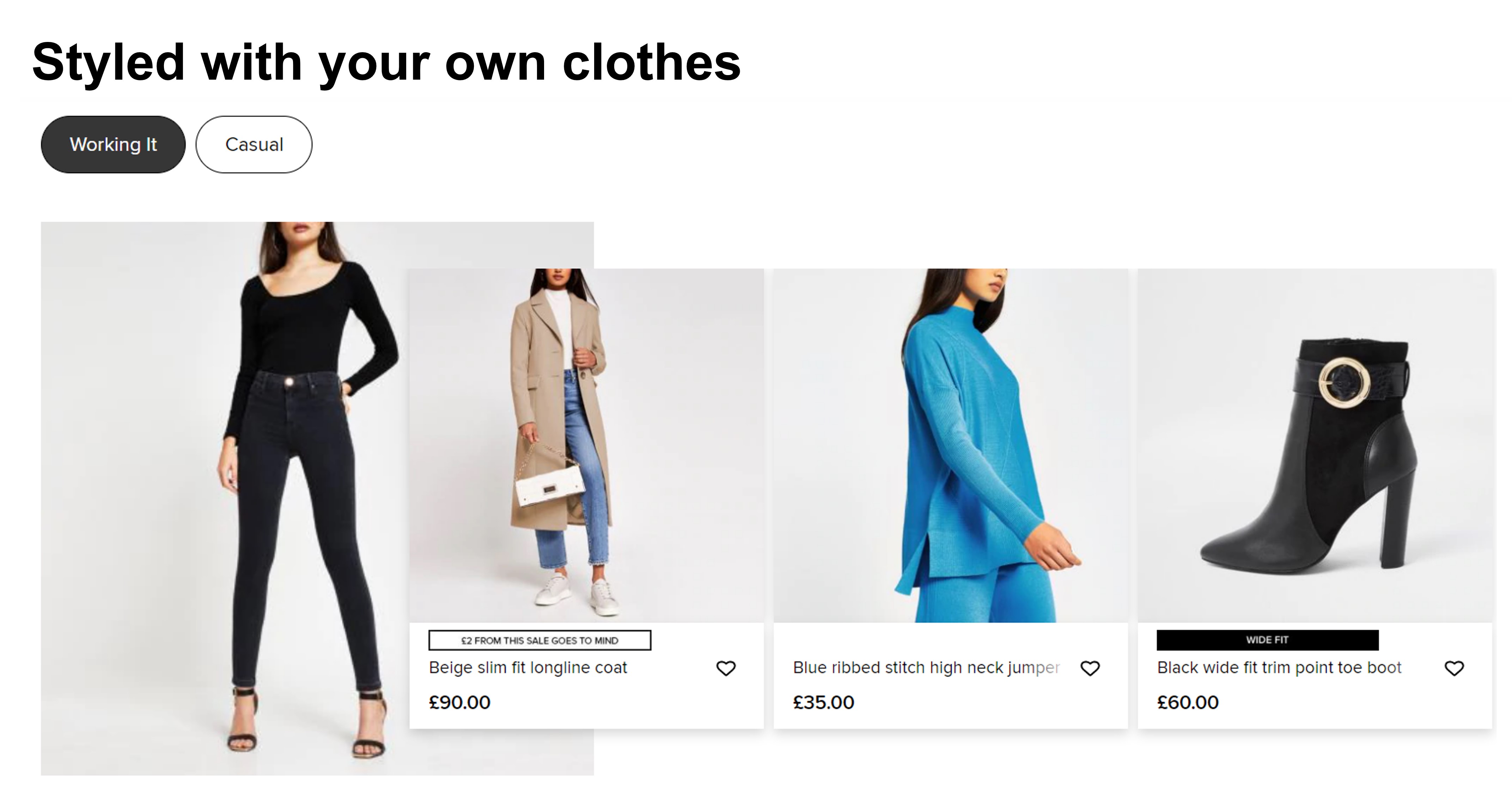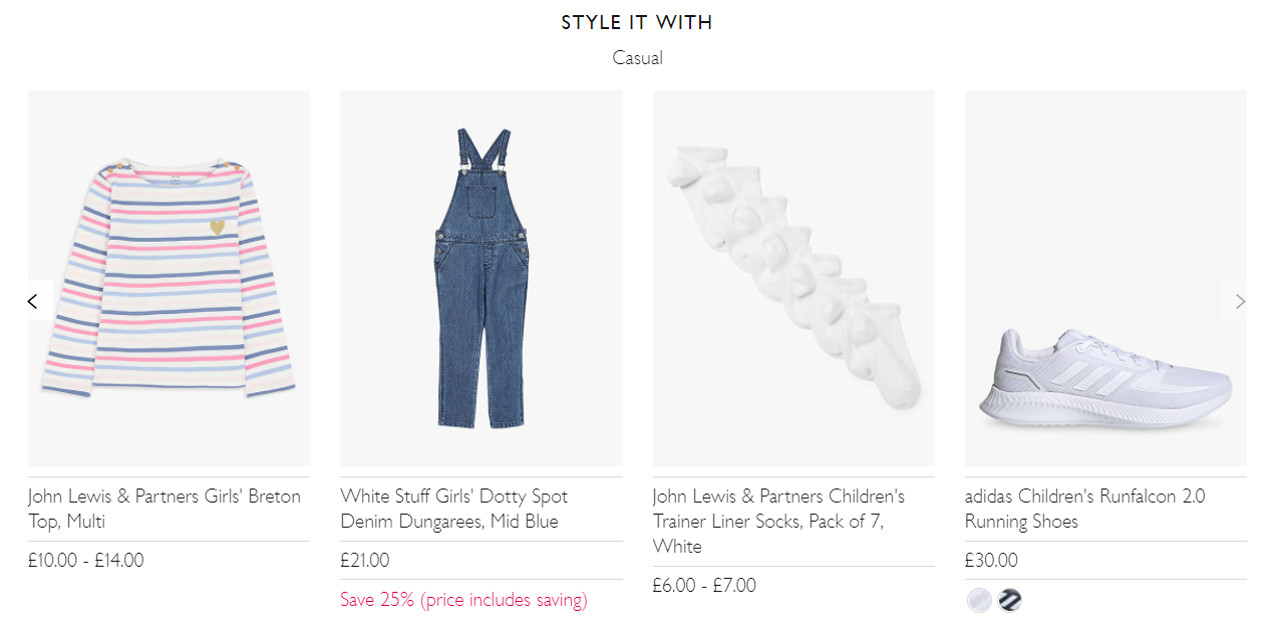Adoption of Artificial Intelligence (AI) is apparent across multiple sectors and has now started to play a crucial role in transforming the fashion industry.
Although the basic retail experience hasn’t changed much over the years from the standard Product Listing Page (PLP) > Product Display Page (PDP) journey, the use of AI in fashion is enabling retailers to make their businesses more efficient, improve the retail experience through personalization and automatically predict trends. AI has the potential to revolutionize fashion retail.
Research shows the size of AI in the retail market exceeded USD 2 billion in 2020 and is expected to grow at more than 30% between 2021 and 2027. Make sure you’re up to date with this growing trend and discover some of the best fashion AI applications.
How to use AI in fashion - applications in 2022
Fashion retailers at the forefront of innovation have already deployed AI across different areas of their business. Here are some of the current applications of AI in the fashion industry:
-
1) Improved customer personalization
-
Retailers are still showing the same products in the same order to all customers regardless of who they are, how frequently they shop or what page they land on.
-
Customers want a relevant and personalized experience and fashion AI will enable this by continually building an understanding of your customers and how they interact with your products at every step. Read our whitepaper on why personalizing the sort order significantly grows revenue and margins. It’s a great fashion machine learning example.
-
Using fashion AI to improve product discovery across the customer journey through personalized recommendations and outfits delivers up to 8% sales growth. This also results in extra profit from selling items at full price, on top of the lower return rates.

-
2) Product forecasting: Most fashion retailers’ margin erosion is a result of the size and shape of how they buy their products. Fashion AI can help retailers move to demand-led predictions of size ratios for every product instead of relying on last year’s data.
-
Fashion retailers often have to make decisions quickly, without having time to sift through all the data. However, using better fashion AI predictive retailing models can help them make better decisions, resulting in increased full-priced sell-through rates and decreased markdowns. In fact, modeling the true demand for a product can eliminate 25% of markdowns.
-
AI data-driven retailing models can also help identify any net “overproduction,” meaning when retailers are effectively buying markdowns from the outset. This can be easily eliminated with the added side benefit of improving the sustainability of the retailer and reducing waste. Another genuine Environment, Social, and Governance (ESG) benefit for everyone.
-
3) AI fashion design: As a creative industry, fashion designers have been slower on the uptake of AI but it can help them do certain functions of their job both better and quicker. This includes automating the design process, generating new designs, and gathering data for manufacturers to understand demand e.g. colors and textures. Zalando trained a neural network with style preferences of more than 600 fashionistas to predict what kind of fashion people might like and to create designs to match them.
-
4) Fashion trend forecasting: No individual is able to sift through the huge amount of data available on products. Companies such as Heuritech use fashion AI to do the heavy lifting and determine the trend forecasts (eg colors, styles, textures). This means product developers are able to use that time to interpret the data and design new garments for retailers. AI is also able to detect early signals from social media and other online platforms.
-
5) Virtual merchandising: Fashion retailers use AI-enable technology such as augmented reality (AR) and virtual reality (VR) to try and bridge the gap between online and in-store experiences. Customers can experiment with different colors, styles and outfits without having to go to the store or get everything delivered in the knowledge they are going to return the majority! Wanna.fashion uses augmented reality to allow you to try on several pairs of sneakers.
-
6) Visual search: Through visual search, customers can input a photo of a garment with no text explanation needed and the search engine will deliver the most relevant results. LykDat is a good example of a reverse image tool that is able to help customers find fashion goods using photographs. This use of fashion AI makes product discoverability a lot easier by giving customers more accurate results than the thousands that might come up for ‘blue midi dress’.
-
7) Automated authentication: Counterfeit products are now becoming more and more similar to the real thing, meaning it is getting even harder for trained eyes to spot fashion forgeries. AI-powered authentication solutions such as Entrupy can be used to detect counterfeits. This is especially useful for marketplaces built on the re-sell model where a large amount of product data and pictures have to be observed quickly.
Top 10 Fashion AI examples from retailers
There have been some interesting partnerships between fashion retailers and AI, all showing that integrating AI into the fashion industry has proven benefits. According to a study by IMRG & Hive, three-quarters of fashion retailers will invest in AI over the next 24 months. Here are some examples of artificial intelligence in online shopping happening now:
-
1) To win in customer experience, retailers these days need to step away from generic approaches and more toward personalization. The team at River Island understood this very well!
-
With the support of Dressipi’s fashion AI they provided their customers with personalized recommendations, outfits and similar items across the entire customer journey. Customers were seeing what they needed, when they needed it, across Product Listing Pages (PLP), Product Display Pages (PDP) and emails. This fashion-focused approach showed in the business results with revenue up by 6% in 12 months!

-
2) Today's customers don't just want to be sold to, they want to get inspired. Using Dressipi’s AI, John Lewis inspired their customers by displaying multiple outfits per garment and by occasion.

-
Whether the customer was looking for ‘Casual’, ‘Creative Work’ or ‘Evening’, John Lewis successfully demonstrated the versatility of the garments. The outfit recommendations saw a significant increase in revenue.
-
3) Successful retailers like Belstaff recognize how important customer-focused innovation is to maintaining a competitive edge in what is currently a challenging retail market. Utilizing Dressipi’s fashion AI, Belstaff can offer shopping experiences that customers are demanding including personalized product and outfit recommendations on the homepage, PDP and emails. This customer-centric approach saw email revenue increase by 69%.

-
4) Macy’s On Call app uses an in store shopping assistant powered by AI. Customers open an app when they’re in the store and can chat with an AI bot to get directions to an item or check if something is in stock.
-
If you’ve ever been lost in a store looking for an item, you’ll recognize the benefit here. Immediacy is something that customers have learned to expect with online purchases with next day deliveries now a norm. It’s great to see Macy’s replicating this in their brick and mortar stores as well.
-
5) Clothing store Uniqlo is pioneering the use of science and AI to create a unique in-store experience. Select stores have AI-powered UMood kiosks that show customers a variety of products and measure their reaction to the color and style through neurotransmitters. It then recommends products based on each person’s reactions.
-
This is invaluable data for retail stores which has, up to now, been collected only online. Online retailers can know what to recommend to customers based on touch points such as what they click on etc. It’s fantastic to see a way of getting these touchpoints in store as well.
-
6) Overstocked and unsold products are something no retailer wants to contend with. This is why staying on trend is increasingly more important. Particularly with the move towards sustainability and the targets that come with it.
-
This is why popular clothing store H&M relies on AI to stay on top of local trends to be successful. The store uses AI to analyze store receipts and returns to evaluate purchases at each store. This in turn drives efficiencies in its supply chain and operations while giving local customers what they actually desire.
-
7) Clothing designer Rebecca Minkoff has taken the brick and mortar shopping experience to a whole new level with the help of connected stores. The designer has stores around the country and is one of the first brands to innovate in this place. The connected stores feature smart walls that suggest new styles for customers, smart mirrors in dressing rooms that allow shoppers to browse for other sizes or save their shopping activity for the future.
-
8) Similar to Rebecca Minkoff, American Eagle is also innovating in their physical stores. The brand is creating interactive dressing rooms that bring some much needed life into the whole, let’s face it often tiresome experience of trying on outfits. Using touch screens, American Eagle customers can now request sizes, scan items, check prices and much more. All in the comfort of the dressing room!
-
9) Nothing can replace human contact, but some tasks can certainly be done by machines. One such task is order pick up. I mean you don’t particularly need a store expert to pick up an item. Their time is better spent on providing valuable style advice or helping customers find that perfect item in the first place.
-
This is why Zara’s AI in fashion case study is interesting. Zara started using robots to help customers when they come to pick up their orders. Customers can quickly and efficiently collect their orders from the store by visiting one of Zara’s pickup stations. The customer simply enters a code which activates an in-store warehouse robot who find the order and deposits it in a dropbox. Simple.
-
10) Looking for a specific item in a shop can be super frustrating. Search catalogs that are based on keywords can be temperamental or simply not accurate enough. This is where image search comes in handy.
-
Neiman Marcus allows users to take pictures of items they see and search then and there. Using AI technology Neiman Marcus is able to use the image to find the same or a similar item. Much better than the thousands of search results that might come up for that ‘blue midi dress’ if visual search was not involved.
Final Thoughts
The impact of AI on the fashion industry is huge and gives retailers that much needed competitive edge. It cuts down errors, helps predict what customers will buy and keep, and has positive effects on revenue and profit. And, how fashion retailers apply this AI will be the future differentiator between fashion retail winners and losers.
With 75% of retailers looking to invest in external technology partnerships to enhance their AI capabilities, can you afford being left behind? Book a free demo and find out how you can deliver outstanding customer experiences.
We’ve got a case study that you might find interesting, follow the link below to read the full story


